Topics
Category
Era
Minneapolis, St. Paul and Sault Ste. Marie Railroad (Soo Line)
The Minneapolis, St. Paul and Sault Ste. Marie Railroad, commonly known as the Soo Line from a phonetic spelling of Sault, helped Minnesota farmers and millers prosper by hauling grain directly from Minneapolis to eastern markets.
Prominent Minneapolis businessmen founded the railroad, originally called the Minneapolis, Sault Ste. Marie and Atlantic, in 1883. But Israel Washburn, governor of Maine and brother of Cadwallader (C.C.) and William Washburn, had proposed such a railroad to the Minneapolis Board of Trade as early as 1873.
William D. Washburn was the railroad's first president and one of its founders, along with Thomas Lowry, Charles Pillsbury, H.T. Welles, John Martin, George R. Newell, Anthony Kelly, C.M. Loring, Clinton Morrison, J.K. Sidle, W.W. Eastman, William D. Hale, and Charles J. Martin. These men paid for the railroad without public money or land grants, which was extremely rare for railroads of the time. Also rare, their railroad had a reputation throughout its history as being free of corruption and irregular business practices.
The railroad's first track ran forty-six miles from Turtle Lake, Wisconsin, to Bruce, Wisconsin. It opened for business in June 1884, leasing connecting track from Turtle Lake to Minneapolis from another railroad, the Chicago, St. Paul, Minneapolis and Omaha. In 1887, the Minneapolis, Sault Ste. Marie and Atlantic Railroad reached the port of Sault Ste. Marie, allowing grain and flour to be shipped directly from Minneapolis to eastern markets by rail for the first time. Previously, Minneapolis and the surrounding area were at a disadvantage, since Chicago- and Milwaukee-based railroads controlled access to markets in the East. The Minneapolis, Sault Ste. Marie and Atlantic Railroad broke their stranglehold and set rates more favorable to farmers and millers of the Upper Midwest.
In 1888, the railroad was renamed the Minneapolis, St. Paul and Sault Ste. Marie, often called the Soo Line. New track was built regularly through 1915, expanding the line across the Upper Midwest and into Canada. Canadian Pacific Railway was a majority stock owner in the Soo Line from 1888 on, but the Soo Line continued for years as a separate company, with Thomas Lowry as president.
The primary business of the Soo Line was hauling grain, but the railroad also carried lumber, iron ore, and passengers. In 1909, it took over operations of the Wisconsin Central Railway, signing a ninety-nine-year lease, to further expand its operations in Wisconsin. Both the Soo Line and the Wisconsin Central slid into bankruptcy during the Depression of the 1930s, with the Soo Line recovering first, in 1944.
The railroad continued to haul freight profitably through the 1950s but discontinued its passenger service as competition from automobiles and lack of ridership cut into profits. Local Soo Line passenger routes were stopped first, in 1959, followed by the line's summer vacation routes. The best known of these routes, the Mountaineer, stopped in 1960. The last Soo Line passenger train anywhere along the line traveled between Milwaukee and Calumet, Michigan, in March 1968.
Years before that, in 1961, the Minneapolis, St. Paul and Sault Ste. Marie officially merged with the Wisconsin Central Railway and the Canadian Pacific-controlled Duluth, South Shore and Atlantic Railroad. They formed one new company, the Soo Line. This company made money immediately and continued to focus on transporting grain.
In 1985, the Soo Line bought one of its longtime competitors, the Chicago, Milwaukee, St. Paul and Pacific (known as the Milwaukee Road). A large part of the Soo Line spun off to form a new Wisconsin Central in 1987, and in the 1990s, Canadian Pacific Railway took over what was left of the Soo Line, ending its existence as a separate company.
Bibliography
Abbey, Wallace W. The Little Jewel. Pueblo, CO: Pinon Productions, 1984.
Atwater, Isaac, ed. History of the City of Minneapolis, Minnesota. vol. 1. New York: Munsell and Company, Publishers, 1893.
Dorin, Patrick. The Soo Line. Seattle: Superior Publishing Company, [1979].
Lydon, James W. History of the Soo Line Railroad. [N.p., 1961?].
Related Resources
Primary
Soo Line Railroad Company Records, 1855–1994
Manuscript Collection, Minnesota Historical Society, St. Paul
http://www2.mnhs.org/library/findaids/00343.xml
Description: Records of the Soo Line Railway Company, a railway founded in Minnesota to serve the local milling and lumber industries.
Railroad Records Collection, 1854–1990
Manuscript Collection, Minnesota Historical Society, St. Paul
Description: Records of the three northern transcontinental railway systems headquartered in the Twin Cities, including the Soo Line.
Railroad and Freight Line Records, 1969–1990
Revenue Department, Alcohol, Tobacco and Special Taxes Division
State Archives Collection, Minnesota Historical Society, St. Paul
http://www2.mnhs.org/library/findaids/rev022.pdf
Description: Records of earnings and payments, plus some legal issues related to the Soo Line.
P1771
William and Herbert Paist Papers, 1849–1932
Manuscript Collection, Minnesota Historical Society, St. Paul
Description: Herbert Paist worked as a railroad station agent, traveling auditor, paymaster, and treasurer for the Soo Line.
Secondary
Danbom, David B. "Flour Power: The Significance of Flour Milling at the Falls." Minnesota History 58, no. 5 and 6 (Spring/Summer 2003): 270–285.
http://collections.mnhs.org/MNHistoryMagazine/articles/58/v58i05-06p270-285.pdf
Gjevre, John A. Saga of the Soo: West from Shoreham. LaCrosse, WI: Molzahn Printing Company, 1973.
Hofsommer, Don L. " 'Temples of Mammon and Hives of Industry': Railroads and the Minneapolis Milling District." Minnesota History 61, no. 6 (Summer 2009): 248–259.
Kuhlmann, Charles B. "The Influence of the Minneapolis Flour Mills Upon the Economic Development of Minnesota and the Northwest." Minnesota History 6, no. 2 (June 1925): 141–154.
http://collections.mnhs.org/MNHistoryMagazine/articles/6/v06i02p141-154.pdf
Pearson, Marjorie and Penny A. Petersen, Hess, Roise and Company. Rapids, Reins and Rails: Transportation on the Minneapolis Riverfront. Prepared for the Saint Anthony Falls Heritage Board, May 2009.
Report from the New Soo. Minneapolis: Soo Line Railroad Company, [1962].
"Thomas Lowry is Dead After Long Illness." Minneapolis Journal, February 4, 1909.
Web
The Minnesota Historical Society. History Topics, Building Railroads.
http://libguides.mnhs.org/rrconstruction
Minnesota Historical Society, Placeography. Soo Line Building.
http://www.placeography.org/index.php/Soo_Line_Building,_501_Marquette,_Minneapolis,_Minnesota
"Railroad Collections at the Minnesota Historical Society." Collections Up Close Podcast and Blog, Minnesota Historical Society, St. Paul, August 9, 2011.
http://discussions.mnhs.org/collections/2011/08/railroad-collections-at-the-minnesota-historical-society/
The Soo Line Historical and Technical Society.
www.sooline.org
Related Images
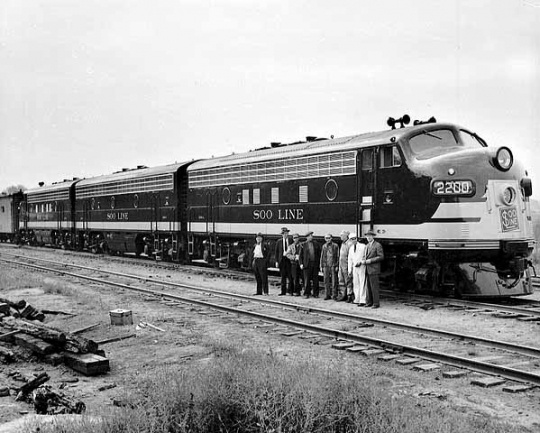
George E. Mackinnon with train crew
Soo Line diesel to Chicago, 1948. Photograph by George Miles Ryan Studio
Holding Location

Soo Line Railway passenger ticket
Soo Line Railway ticket, including free admission to the Exposition Building, October 1888.
All rights reserved
Holding Location
More Information
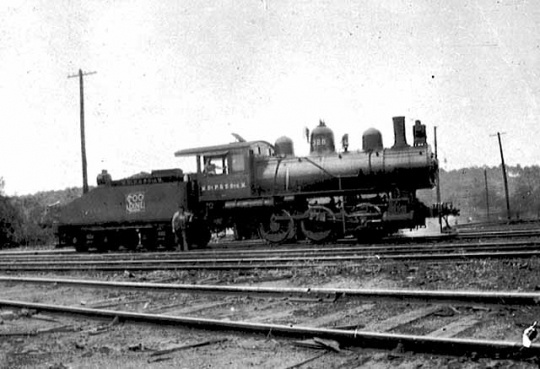
Minneapolis, St. Paul & Sault Ste. Marie Railway Company locomotive
Minneapolis, St. Paul and Sault Ste. Marie Railroad locomotive, c.1890
Public domain
Holding Location
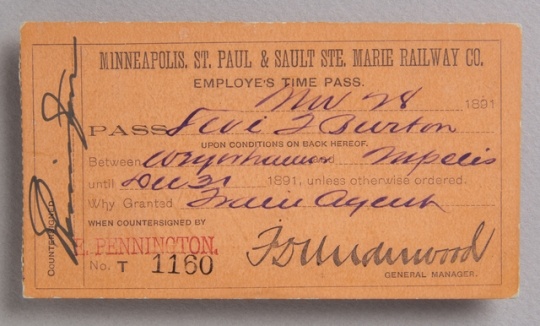
Soo Line Railway employee's time pass
Soo Line railway employee’s time pass, 1891
All rights reserved
Holding Location
More Information
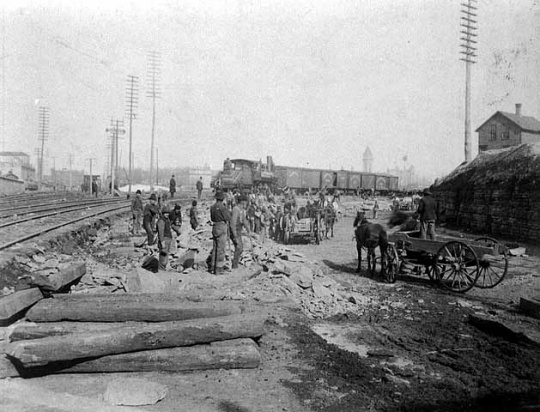
Extending Soo Line tracks, Minneapolis
Extending Soo Line tracks, Minneapolis, 1892.
Public domain
Holding Location
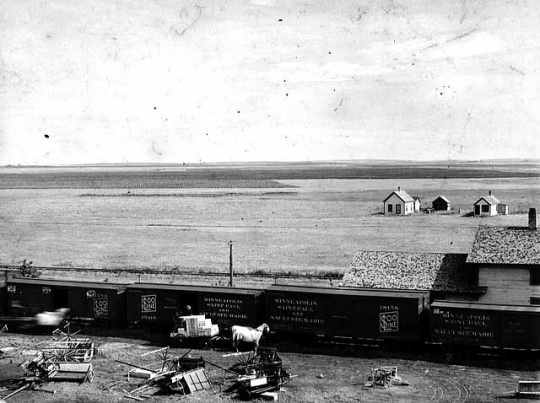
Arrival of harvesting machinery by train
Arrival of harvesting machinery by Soo Line train, possibly in the Red River Valley, c.1895
Public domain
Holding Location
More Information
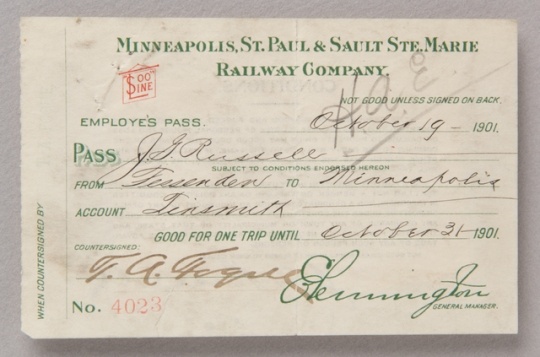
Soo Line Railway employee pass
Soo Line railway employee pass, 1901.
All rights reserved
Holding Location
More Information
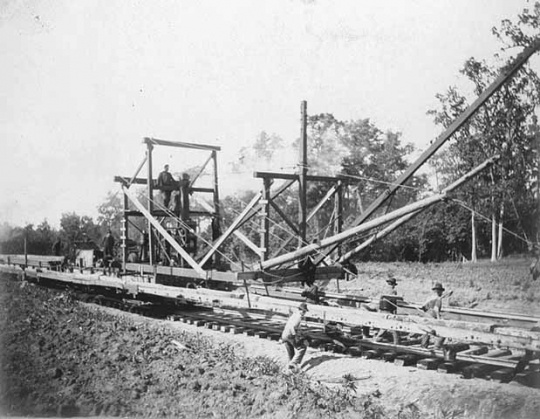
Laying track near Detroit Lakes
Laying track near Detroit Lakes, Soo Line Railway Company, 1904.
Public domain
Holding Location
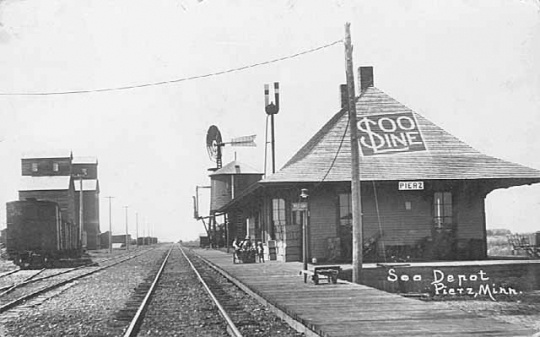
Soo Depot, Pierz
Soo Line depot, Pierz, c.1915.
Public domain
Holding Location
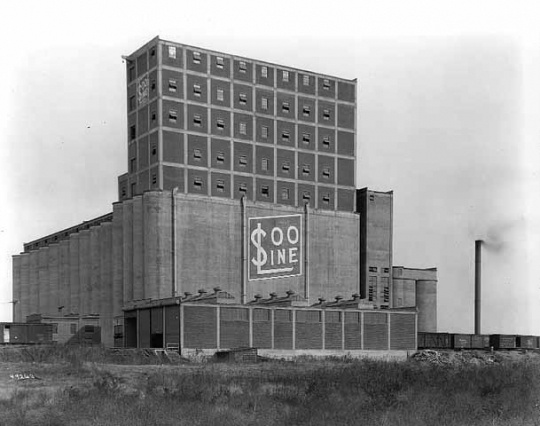
Soo Line Terminal Elevator
Soo Line terminal elevator, Forty-Eighth and Penn Avenues North, Minneapolis, 1923. Photograph by Charles J. Hibbard
Holding Location
More Information
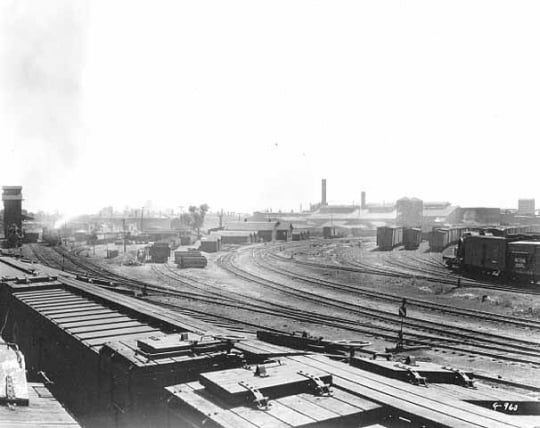
Soo Line Shops and yard, Minneapolis
Soo Line shops and yard, Minneapolis, c.1925. Photograph by Charles P. Gibson.
Holding Location
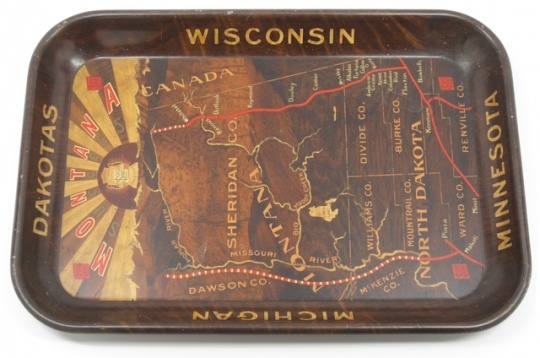
Soo Line dining car tray
Soo Line dining car tray showing map of Soo Line route, 1930s.
All rights reserved
Holding Location
More Information
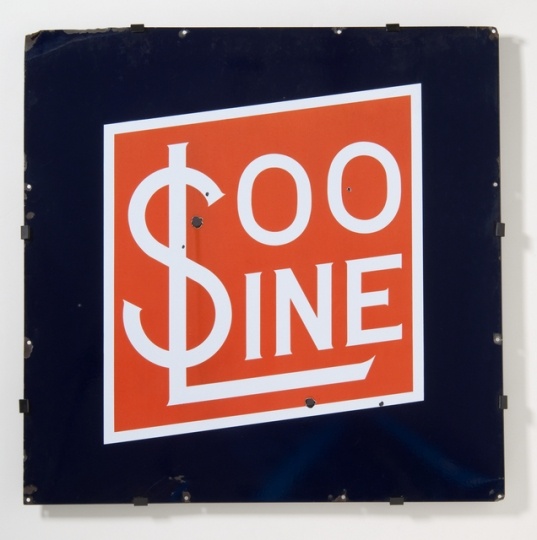
'Soo Line' sign
Enameled steel Soo Line sign from the mid-twentieth century. Manufactured by Vertibrite Signs, Chicago.
All rights reserved
Holding Location
More Information
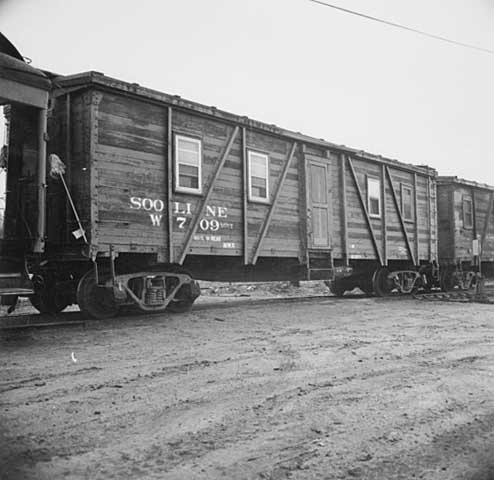
Soo Line wooded box cars at Shoreham Yards
Soo Line wooded boxcars at Shoreham Yards, Central Avenue and Twenty-Eighth, Minneapolis, 1982. Photograph by R. G. Smedley
Holding Location
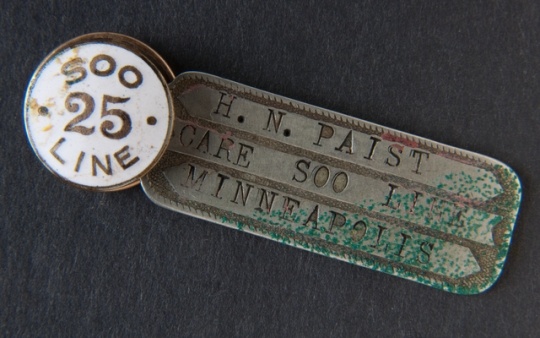
Herbert Paist's Soo Line pin
Two-part Soo Line lapel pin used by Soo Line employee Herbert Paist
All rights reserved
Holding Location
More Information
Related Articles
Turning Point
In 1887, the Minneapolis, Sault Ste. Marie and Atlantic Railroad (later called the Soo Line) reaches the port of Sault Ste. Marie, Michigan, opening the first direct rail route from the grain markets of Minneapolis to the markets of the East.
Chronology
1883
1884
1887
1888
1909
1944
1961
1968
1985
1987
Bibliography
Abbey, Wallace W. The Little Jewel. Pueblo, CO: Pinon Productions, 1984.
Atwater, Isaac, ed. History of the City of Minneapolis, Minnesota. vol. 1. New York: Munsell and Company, Publishers, 1893.
Dorin, Patrick. The Soo Line. Seattle: Superior Publishing Company, [1979].
Lydon, James W. History of the Soo Line Railroad. [N.p., 1961?].
Related Resources
Primary
Soo Line Railroad Company Records, 1855–1994
Manuscript Collection, Minnesota Historical Society, St. Paul
http://www2.mnhs.org/library/findaids/00343.xml
Description: Records of the Soo Line Railway Company, a railway founded in Minnesota to serve the local milling and lumber industries.
Railroad Records Collection, 1854–1990
Manuscript Collection, Minnesota Historical Society, St. Paul
Description: Records of the three northern transcontinental railway systems headquartered in the Twin Cities, including the Soo Line.
Railroad and Freight Line Records, 1969–1990
Revenue Department, Alcohol, Tobacco and Special Taxes Division
State Archives Collection, Minnesota Historical Society, St. Paul
http://www2.mnhs.org/library/findaids/rev022.pdf
Description: Records of earnings and payments, plus some legal issues related to the Soo Line.
P1771
William and Herbert Paist Papers, 1849–1932
Manuscript Collection, Minnesota Historical Society, St. Paul
Description: Herbert Paist worked as a railroad station agent, traveling auditor, paymaster, and treasurer for the Soo Line.
Secondary
Danbom, David B. "Flour Power: The Significance of Flour Milling at the Falls." Minnesota History 58, no. 5 and 6 (Spring/Summer 2003): 270–285.
http://collections.mnhs.org/MNHistoryMagazine/articles/58/v58i05-06p270-285.pdf
Gjevre, John A. Saga of the Soo: West from Shoreham. LaCrosse, WI: Molzahn Printing Company, 1973.
Hofsommer, Don L. " 'Temples of Mammon and Hives of Industry': Railroads and the Minneapolis Milling District." Minnesota History 61, no. 6 (Summer 2009): 248–259.
Kuhlmann, Charles B. "The Influence of the Minneapolis Flour Mills Upon the Economic Development of Minnesota and the Northwest." Minnesota History 6, no. 2 (June 1925): 141–154.
http://collections.mnhs.org/MNHistoryMagazine/articles/6/v06i02p141-154.pdf
Pearson, Marjorie and Penny A. Petersen, Hess, Roise and Company. Rapids, Reins and Rails: Transportation on the Minneapolis Riverfront. Prepared for the Saint Anthony Falls Heritage Board, May 2009.
Report from the New Soo. Minneapolis: Soo Line Railroad Company, [1962].
"Thomas Lowry is Dead After Long Illness." Minneapolis Journal, February 4, 1909.
Web
The Minnesota Historical Society. History Topics, Building Railroads.
http://libguides.mnhs.org/rrconstruction
Minnesota Historical Society, Placeography. Soo Line Building.
http://www.placeography.org/index.php/Soo_Line_Building,_501_Marquette,_Minneapolis,_Minnesota
"Railroad Collections at the Minnesota Historical Society." Collections Up Close Podcast and Blog, Minnesota Historical Society, St. Paul, August 9, 2011.
http://discussions.mnhs.org/collections/2011/08/railroad-collections-at-the-minnesota-historical-society/
The Soo Line Historical and Technical Society.
www.sooline.org
















